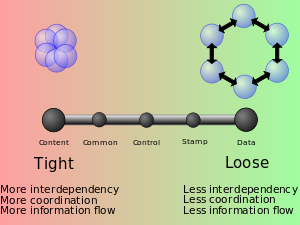Coupling
In software engineering, coupling is the degree of interdependence between software modules; a measure of how closely connected two routines or modules are;[1] the strength of the relationships between modules.
Coupling and cohesion Coupling is usually contrasted with cohesion. Low coupling often correlates with high cohesion, and vice versa. Low coupling is often thought to be a sign of a well-structured computer system and a good design, and when combined with high cohesion, supports the general goals of high readability and maintainability.
Types of Coupling

Procedural programming
A module here refers to a subroutine of any kind, i.e. a set of one or more statements having a name and preferably its own set of variable names.
-
Content coupling (high)
Content coupling is said to occur when one module uses the code of another module, for instance a branch. This violates information hiding – a basic software design concept.
-
Common coupling
Common coupling is said to occur when several modules have access to the same global data. But it can lead to uncontrolled error propagation and unforeseen side-effects when changes are made.
-
External coupling
External coupling occurs when two modules share an externally imposed data format, communication protocol, or device interface. This is basically related to the communication to external tools and devices.
-
Control coupling
Control coupling is one module controlling the flow of another, by passing it information on what to do (e.g., passing a what-to-do flag).
-
Stamp coupling (data-structured coupling)
Stamp coupling occurs when modules share a composite data structure and use only parts of it, possibly different parts (e.g., passing a whole record to a function that needs only one field of it).
In this situation, a modification in a field that a module does not need may lead to changing the way the module reads the record.
-
Data coupling
Data coupling occurs when modules share data through, for example, parameters. Each datum is an elementary piece, and these are the only data shared (e.g., passing an integer to a function that computes a square root).
Object-oriented programming
-
Subclass coupling
Describes the relationship between a child and its parent. The child is connected to its parent, but the parent is not connected to the child.
-
Temporal coupling
It is when two actions are bundled together into one module just because they happen to occur at the same time.
In recent work various other coupling concepts have been investigated and used as indicators for different modularization principles used in practice.
Dynamic coupling
The goal of this type of coupling is to provide a run-time evaluation of a software system. It has been argued that static coupling metrics lose precision when dealing with an intensive use of dynamic binding or inheritance.[6] In the attempt to solve this issue, dynamic coupling measures have been taken into account.
Semantic coupling
This kind of coupling considers the conceptual similarities between software entities using, for example, comments and identifiers and relying on techniques such as latent semantic indexing (LSI).
Logical coupling
Logical coupling (or evolutionary coupling or change coupling) exploits the release history of a software system to find change patterns among modules or classes: e.g., entities that are likely to be changed together or sequences of changes (a change in a class A is always followed by a change in a class B).
Disadvantages of tight coupling
Tightly coupled systems tend to exhibit the following developmental characteristics, which are often seen as disadvantages:
- A change in one module usually forces a ripple effect of changes in other modules.
- Assembly of modules might require more effort and/or time due to the increased inter-module dependency.
- A particular module might be harder to reuse and/or test because dependent modules must be included.